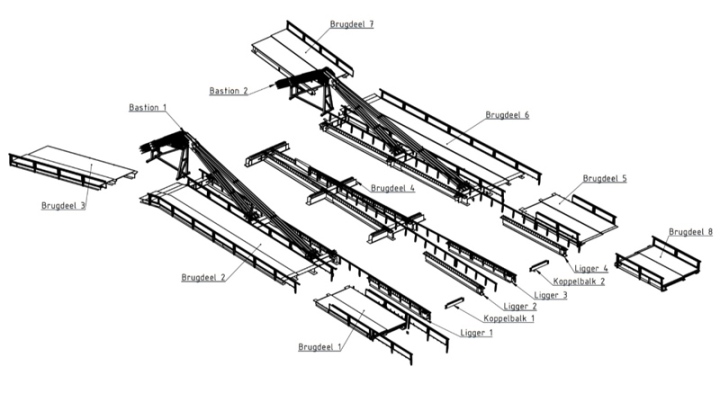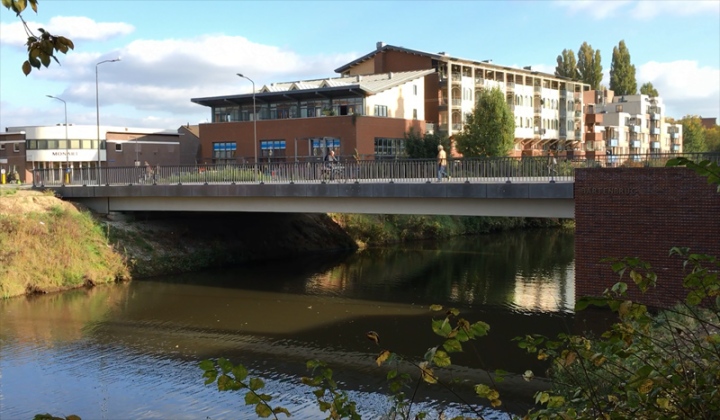When it comes to building infrastructure, the Dutch do like to think that they are rather good at it. I’ve shown you a lot of examples on my blog that would seem to support that view. But, you can’t always do things right! Mistakes are sometimes made. Occasionally mistakes become blunders and sometimes projects are so badly executed, that there are just no words for it. The ʼs-Hertogenbosch Bartenbrug, (Barten Bridge) is one such project. The Bossche Blunder Brug as the local press called it. (I don’t think you need a translation for that phrase.) They also called it Murphy’s Bridge, because everything that could go wrong did go wrong in this bridge project.


The old Bartenbrug was built in 1937. In 2000, during a regular inspection, it turned out to be in such a bad condition that heavy traffic needed to be banned from using it immediately and it was advised to completely replace the bridge. In 2003, the city indeed decided to replace the bridge, before the end of 2008. A similar new bridge would cost about 1.5 million euros, but the city had found extra money and the council wanted to build something special at this location. The bridge spans the river Aa, a canalised river, that doubled as the ʼs-Hertogenbosch city moat. Historic fortifications had just been revealed right next to the bridge, which had been implemented in a new park. In 2004 the city organised a design contest for a very special bridge. The winning design would be built. The city thought that that should be possible for a budget of about 3 million euros.

The winning design was created by an artist, Inge Burg, who worked for an architect’s collective. She designed a series of four suspended bridges with two large pylons. This design was a modern reference to old draw bridges that would have spanned the city moat long ago. When the city tried to find a contractor to build the design, it turned out to be much more expensive than they had hoped for. Most contractors asked about 4.5 million euros and the city was not prepared to spend that much money. This dragged on for several years, until finally, in 2011 the council found one contractor who was prepared to build the bridge for 2.7 million euros.

In June 2012, the contractor started with the demolition of the old bridge, after a temporary bridge was built for walking and cycling. Motor traffic had to make a long detour. Within one month, however, the building was stopped. It turned out the available design schematics did not meet the minimum criteria of plans that you could build a bridge from. Years later, in thorough investigations into everything that went wrong here, it was revealed that city officials had assumed the plans were fine, coming from a renowned architectural firm, but they lacked the knowledge to judge that. This meant that necessary calculations to establish that the bridge would be safe, or even, that the bridge could be built at all, had never been done. The contractor blamed the city and vice versa and all the works were stopped. Since it was unknown how long the works would be postponed and under pressure of shop owners in the area, the city built a temporary bridge for one-way motor traffic that was opened in November 2012. That meant the area could also be reached by motor traffic again.

After long debates, the contractor and the city agreed to have the plans updated to something the contractor could work from. Who was to pay for the extra work would be sorted later. In May 2013, after the temporary bridge for motor traffic was taken down again, the works were restarted. But… not for very long!

At the site of the bridge, the concrete pylons were built without problems. (Personally, I thought they were awfully big for the location.) Off site, however, in the factory where all the steel parts were constructed, things didn’t go so well. Quality controls showed the steel had tiny cracks and some parts had also bend. This was in November 2013 and the work was stopped once again. Because it was again unknown how long this new delay would last, a second temporary bridge for motor traffic was built. It opened in March 2014. A short time later, in May 2014, independent researchers advised the city not to use the steel parts that were already built, not even if they would be repaired, because the quality of the steel could never be trusted. It was advised to construct all steel parts anew. This deepened the conflict between the city and the contractor. Both issued further investigations into the feasibility of the entire project and they bring even worse news. It is October 2014 and the final verdict is: this bridge can never be built in a safe and reliable way.


With already almost 10 million euros spent, and with a half-finished bridge at the site, the city council could only take a drastic decision. In December 2014, the council unanimously decided to destroy everything that was already built, to completely discard the winning bridge design and to start all over again.

The large concrete pylons were constucted so well, that they had to be demolished using controlled explosives. A lot of the demolition work had to be done by hand. This only added to the enourmous costs that had already been made for the failed bridge.
In June 2015, a new open tender was started and from the submitted designs the city chose a design by IPV-Delft. This is the firm you could know from the Hovenring in Eindhoven, a cycle bridge in Enschede and the submerged cycle bridge in Haarlem. All IPV-Delft-designs that I showed you on this blog. The new – very simple – design was then realised in just seven months, two months quicker than planned. The new Bartenbrug was opened to all traffic on 10 August 2016. Quite a long time after the 2003 decision to replace the original bridge! There’s not much to be said about the new bridge, that has wide protected one-directional cycleways at either side. The only thing I do not understand are the large concrete blocks between the cycleways and the roadway. They seem unnecessarily dangerous for people cycling.

This entire project can serve as a horror example of what not to do when building infrastructure. Not only did over 10 million euros go down the drain here, an alderman for traffic, the director of public works and three project leaders lost their jobs. Legal procedures are still ongoing to determine who should pay for all the mistakes. Last October, a court ruled that the city is to blame most, so it seems most of the millions will have to be paid for by the people of ʼs-Hertogenbosch. The last won’t be said about this disaster, but at least it is no longer visible in the street. A usable, decent bridge has finally been built. After using the temporary cycle bridge for more than four years, that does take some time to get used to!
My video about the Bartenbrug fiasco.


As the saying goes………………Doing it right the first time will always pay off.
Oh my! In hindsight one can see the “obvious” warning signs that were missed (eg the low ball bid by one contractor), the points when critical mistakes (never assume! it makes an ass out of u and me) were made in the project management process, and the optimism bias (not overly, given the awesome bridges the Dutch have designed and built) that featured in this sorry saga. Luckily this wasn’t a mega project where the same mistakes are often made where the cost overruns are in the billions (refer Bent Flyvbjerg’s writings about this).
As a civil engineer I have some empathy for those who are deemed “guilty”, however we are paid well to do a professional job and with that comes responsibility.
At least it didn’t get built to allow it to collapse.
Perhaps one might twist a couple of well-known sayings here: doe maar gewoon, dan doe je al gek genoeg “Just build a normal bridge, that’s crazy enough” and Carl Sagan’s “Extraordinary [bridge designs] require extraordinary evidence”.
Contest -> Artist – > Architect gives some concerns for starting a structural project. Stylised design adds some more. Contractors quoting way over the estimate should be the final warning sign – they are very good at spotting where there are design or contractual risks.
Should have hired chinese company to do the bridge 🙂 😉
100 % agree.
Neat bit of tech, quite nice for building road and railway bridges, but A it’s not needed for a bridge this small and it is possible to hire Dutch workers, just get a license to use the patent if there still is one. Calgary used it for it’s LRT system and I quite liked that extension.
Those concrete pylons were hideous. I think the new one is much better and non-intrusive (of course without seeing any of it in the flesh 🙂
Well, the people of Melbourne have to pay a BILLION dollars for a road project that will not go through, due to all sorts of political shenanigans 😡
Why in projects like this are the people on the hook for the wasted money? That’s your tax money Mark, you had nothing to do with these failures. Same with a lot of other rather large projects, a large bridge is being held up in my city, delayed about a year and half, some girders for a different bridge bent overnight in March 2015, a light rail line’s signaling system is getting desperate, etc. Why in so many places around the world are large engineering projects getting to be so expensive on the part of the government? If it really is the city that is responsible, go fine the specific people who are responsible for that, don’t make you spend 20 extra euro in your bill from the belastingdienst.
If the contractor is at fault then perhaps, but you can’t fine a city employee (or 2 or 3) for 10 million Euro.